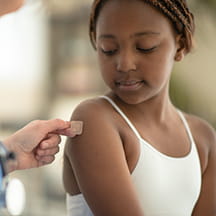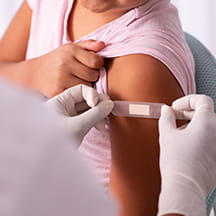When a patient arrives at the Children’s Hospital Colorado Health Pavilion, they’re greeted with a “welcome” in their language—Soo Dhawow, Bienvenue, Chao Mung. This small gesture represents the big ambition of the Aurora Health Pavilion, which is home to eight different social service partners through a department called Resource Connect.
“We're trying to emphasize the idea of a medical home and co-locate as many social services as we can to support whole child health,” said Susan Goldenstein, director of community impact.
Around 80% of Resource Connect’s patients are insured by Medicaid, and the community is highly diverse, speaking around 160 different languages. For five years, Resource Connect has provided immediate referrals in person to onsite services like legal aid, housing navigation, and utility bill support. Nearly 5,000 patients have been connected since its opening in October 2019.
All patients fill out a social (and psychological) needs screening during well-child visits and are paired with a community navigator who connects them to the appropriate resources. Resource Connect’s services include:
- Public benefits eligibility. A technician helps families with Medicaid, SNAP, and TANF applications. “This has been one of the most successful services to have on site,” Goldenstein said.
- Housing support. An in-house navigator helps families with the application process for county/city housing resources.
- Legal services. The hospital’s medical-legal partnership assists families with services, such as housing (efforts to prevent eviction), education and guardianship.
- Special supplemental nutrition. A county Women Infants and Children (WIC) program provides assistance for enrollment, nutritional counseling, and breastfeeding support.
- Utility bill payments. Energy Outreach Colorado helps pay families’ utility bills and HVAC repairs.
- Food security. Using a food-as-medicine model in the Healthy Roots Food Clinic, hospital dietitians and health educators provide a consult and education, and patients shop for a week’s worth of nutrient-rich groceries up to six times a year.
- Employment assistance. Adams County Workforce and Business Center helps families secure employment or increasing employment.
- Tangible goods. A Precious Child provides everyday goods like school supplies, diapers, formula, clothing, sports equipment, and more items not covered by public benefit programs.
“Being on site with us also helps our partners secure language services,” Goldenstein said. “We have an iPad video interpreter on wheels, and some of our partners would not have any way of communicating with our families in their preferred language in their own facilities in the community. But being on site with us, they get to use our language resources, which has been really helpful.”
Defining success
When Julie Beaubian, operations manager over Resource Connect, and her team were developing the program, they made sure to meet with each partner to discuss their idea of success. “This was a really important conversation to have because what success looks like varies greatly across partners,” said Claire Peters, MPH, program manager of Community Health Analytics at Children’s Colorado. They have varying interventions, durations, and eligibility, among other differences. “For the Healthy Roots Food Clinic, once a patient is referred, they are eligible to access food immediately; so, if you come to your appointment, that’s a successful referral. Whereas, for housing there can be a lot of different variables and complexity to those services that impact the outcome.”
Sometimes, a community navigator will determine the family needs a service not included in Resource Connect, and they’ll ensure they get connected.
Documenting and measuring
Peters and her team measure the impact of the program using an evaluation framework called RE-AIM, which measures reach, efficacy, adoption, implementation, and maintenance. Their main focus is the first three areas, Peters said.
Reach. “We're looking to see who's coming into Resource Connect, getting a good sense of the demographics, the volumes, and the types of services they're needing.”
Efficacy. “What percentage of families are successfully getting the services that they need? How does that vary by partner and where are there opportunities for improvement?”
Adoption. “The psychosocial screener drives the referrals to Resource Connect. If that's not happening in a clinic, we're much less likely to see a patient or family come in.”
Key to this work is documenting patients’ activity and outcomes with the partners in Epic, which is done by the Resource Connect navigators. That info is pulled into a dashboard Epic analysts built for measuring Resource Connect’s impact. “The documentation is dynamic and can respond to changes in the application or changes to the outcome, and it's just one referral that encompasses all of the partners’ activities,” Peters said.
Results
Last year, the Resource Connect team published a descriptive paper highlighting the program and its success rate. They found about 20% of social screens were positive, and of those, a third were referred to Resource Connect. Many who weren’t referred were connected to different resources that met their needs. Of the referrals, 75% were successful.
In the end, some of the most valuable results can’t be quantified. “There's a significant amount of trust and dignity patients and families experience by going into Resource Connect, and I feel that is a contributor to the success that we have,” Peters said.
What’s next: reimbursement
“Resource Connect works because of its comprehensiveness and the strength of its partnerships with our primary care clinics and community-based services,” Goldenstein said. “Our approach relies heavily on philanthropic support since many of the social services provided are not reimbursable by Medicaid or private insurers. We aim to change that.”
With its robust data collection, the Resource Connect team is striving to demonstrate that this model of care can positively change health outcomes, especially for underserved children and families, and make the case for reimbursement in the not-too-distant future.
Goldenstein said, “This model of care truly has the potential to lead lasting change for all families, and especially those families who experience the greatest health disparities.”
Goldenstein's presentation was part of the educational session, "Addressing Social Needs with Community Partners,” at Children's Hospital Association’s 2024 Transforming Quality Conference.



